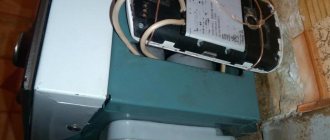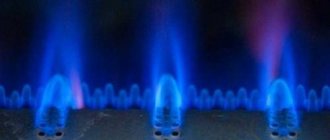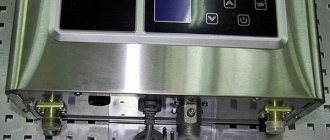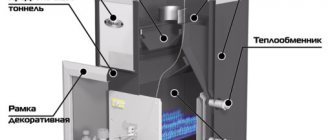What batteries are needed for a geyser: their features
- The price of devices with a hydrogen generator is much higher than the price of speakers with batteries
- The hydrogenerator is very sensitive to water quality. Therefore, it will require constant cleaning.
- The pressure in the plumbing system is sometimes too small to create a normal spark.
The fact that the nutrient elements in the column need to be replaced is indicated by idle attempts to start more than once. More modern devices have an indicator light indicating that the battery charge is reduced to a minimum.
Batteries for geysers: which ones are specifically used
Geysers use special class D batteries (not finger or little finger batteries).
The sum of their voltages should reach the standard 3 volts. Of the batteries suitable for geysers, three types should be distinguished:
- D-R20. The filling of these batteries is salt. They have a low cost, but at the same time have a very fast discharge rate. Service life is about 2 weeks
- D-LR20. The filling is lye. These batteries are much more expensive, but can last up to 6 months.
- Rechargeable batteries are also used for ease of use. The optimal choice would be the NIMH D HR 20 model. With proper use, such nutrients will last up to 5 years.
Tips for choosing batteries
The ideal option would be to purchase batteries exactly matching the original ones. When purchasing other items, you should pay attention to the following points:
- There should be no defects on the external part of the product
- Packaging integrity
- The battery must have the correct shape
All of the above tips should be taken into account, since on the modern market there are not only originals, but also a large number of fakes. And as a result of using batteries of inadequate quality, device breakdowns (including fires) may occur.
Reasons why batteries quickly fail
If the speaker uses high-quality batteries, but nevertheless they lose their charge much faster than expected, it’s worth thinking about. There may be several reasons for this:
Increased moisture content in the room
As a result of excessive humidity in the room, the process of oxidation of the metal parts of the device occurs. As a result, corrosion occurs, which will also affect the column contacts. A characteristic sign of this situation is overheating of the batteries. To avoid such a situation, a good ventilation system in the room and its regular ventilation are necessary.
Errors in the operation of the ionization sensor
The job of this sensor is to monitor the emerging fire in the device. If the sensor deviates from its position, it does not “observe” the fire. And in this situation, the dispenser valve stops supplying gas. And it turns out that the nutrient elements supply a charge in vain. This problem should be monitored and resolved by simply adjusting the position of the sensor.
Electrode shift for ignition
This problem is similar to the previous one and also lies in the physical deviation of the element (electrode) from its true position. In this situation, ignition of the fire may take much longer than usual, which increases energy consumption.
Malfunctions in the control part of the column
The speaker control unit receives electricity from batteries. If it contains minor defects, it will spend significantly more energy than usual. If this problem occurs, it is better to seek help from professionals. Otherwise, you can disrupt the fine settings of the device, or completely disable it.
Replacing batteries in a gas water heater
Replacing old batteries yourself is not difficult. But nevertheless, it should be carried out carefully so as not to damage expensive equipment. In most cases, the battery compartment is located at the bottom of the device.
By design, this department can be of two types:
- The drawer can be opened by pressing its wall
- in a compartment closed with latches, the nutritional elements are often located vertically and are kept from falling by a latch when removed.
The process of replacing old batteries consists of the following steps:
- Turn off the device
- Open the compartment with nutrients and replace them while observing the polarity
- Connect the device to the water and gas supply
Connecting a power supply to the speaker (without using batteries)
You can make such a modification to the column yourself. As a result, you can significantly save on purchasing new batteries. The device will operate from the general electrical network.
The disadvantages of such modernization include:
- If there is no electricity, there will be no hot water.
- This “re-equipment” of the system will most likely deprive the possibility of free service of the device under warranty.
To remake the speaker, you will need an adapter with an input voltage of 220 V and an output voltage of 3 V. The marking of the desired device will contain the following designations 220V3V500 mA.
The procedure for connecting a speaker consists of the following steps:
- Disconnect the wires in the device's power box.
- Disconnect the plug from the purchased adapter and connect the corresponding wires with the wires in the column using soldering. It is important to maintain polarity!
- Connect the wiring in the gas water heater
- Connect the power supply to the electrical network and check the functionality of the equipment.
To avoid the consequences associated with power surges, it is worth adding a special element to the system - a stabilizer.
How to turn on a gas water heater without a battery
This method exists, although it is dangerous. To turn on the column, you need to open the hot water supply valve and bring a match to the burner. The gas will ignite and the column will start working.
It must be remembered that this method is very dangerous to life and health, as it can lead to an explosion. Whenever manipulating gas appliances, it is worth remembering that gas is a very dangerous substance, coupled with open flames and sources of electricity.
Therefore, any actions to replace or repair such equipment must be accompanied by strict adherence to safety precautions
Instructions for replacing old batteries
If you do not know how to properly change the batteries in a gas water heater so as not to damage anything, we recommend that you carefully read our instructions - then we will describe in detail the process of replacing batteries so that none of the users have any difficulties in performing this task.
The batteries are located in an easily accessible place, often at the bottom of the case, and can be easily removed.
In fact, the special battery compartment can have two types of configuration:
- retractable;
- on latches.
Pull-out boxes are opened by pressing on their wall.
In compartments that are closed with latches, batteries are often installed vertically. The batteries are held in place with a special latch, so they do not fall out of the box when opening the box.
Depending on the design features of the speaker, the batteries can be positioned vertically or horizontally, for example, in the “Neva” speaker model.Replacing worn-out batteries in a gas water heater takes place in several successive stages:
- It is necessary to turn off the gas and water supply to the column.
- Carefully open the battery compartment by pressing on its side or bending the locking latches.
- Remove old batteries.
- Install new batteries, observing polarity.
- Return the box to its place (or close the lid). Correct installation is characterized by a characteristic click.
- Resume water and gas supply.
All that remains is to conduct a test run to ensure that the equipment operates correctly.
Batteries for geyser
The development of electronics has led to the automation of many systems and mechanisms. Control of various systems often requires constant power supply, and where high current is not required, conventional batteries can be successfully used.
In modern water heating devices, for example in the Neva gas water heater, chemical batteries are also installed. In such gas appliances, electric current is necessary to generate a spark.
Why are batteries needed in a gas water heater?
The battery in a gas water heater is used for the sole purpose of igniting gas using a spark. Despite the low voltage and power of the batteries, the formation of a spark is carried out by the electrical system, in which the voltage increases to such values that the air is pierced by a discharge.
Considering the relatively large energy consumption during ignition, only products with certain parameters can be used for installation in water heating geysers.
What batteries are needed for a gas water heater?
The following types of products are suitable for installation in gas water heaters:
The first type is an alkaline element. These batteries last for 5 – 6 months. The R20D is a conventional salt power source that will need to be changed quite often, because cheap products dry out very quickly. Both batteries have a voltage of 1.5 volts.
Alkaline batteries allow you to change the battery less frequently. But both batteries cannot be charged later. You can save money if you install a battery instead of a disposable power source.
Can it be replaced with batteries?
Despite the higher cost, operating batteries will be much cheaper than using alkaline D-LR20 or saline D-R20. It is especially important to install a battery if the gas burner will be ignited frequently.
There are Li-Ion (32650), NiCd battery type D and NiMH D-HR20. The battery will have a different voltage (1.2v and 3.7v), so it is very important to make sure that your specific speaker model supports this voltage. You can find out about this in the operating instructions and by getting advice on the manufacturer’s official websites.
On the market you can find D-type batteries with a voltage of 1.5 volts, for example D-Size 1.5v from Znter.
If you have purchased a high-quality battery and a charger for it, then for 5 - 6 years you will not have to remember the need to purchase elements for a gas water heater. You can completely abandon the use of batteries if you install a power supply unit operating from a 220 V network instead of batteries.
What to look for when choosing a battery
- The purchase of counterfeit products or products that have been subjected to mechanical damage or increased temperature during storage and transportation can negate all efforts to restore the functionality of gas equipment.
- Such a battery can last only a few days and you will need to go to the store again for a new battery.
- To minimize the likelihood of purchasing low-quality products, you must:
- Make sure the column supports this voltage.
- The larger the capacity, the longer it will work.
- You should carefully inspect the battery for abrasions, scratches and dents.
- Determine the shelf life of the product, which may be indicated on the product body and packaging.
- Do not purchase products from dubious retail outlets.
How to replace the battery
In flow-through heating equipment, the DC source is located in a separate plastic housing. The casing is located on the bottom edge of the heater; replacing the battery does not require turning off the water supply or gas. To complete the job, you will need a Phillips screwdriver, a plastic spatula and a piece of sandpaper (used to remove oxidation marks from the contact plates).
Algorithm for installing new batteries in a gas heating column:
- Turn off the hot water supply and make sure the gas supply is turned off.
- Unscrew the screw or unfasten the latch holding the compartment cover. Remove the protective cover by removing the pins from the holes.
- Remove the dead batteries using a plastic spatula.
- Inspect the contact pads located inside the housing. If a green coating is found on metal parts, the surface is cleaned with sandpaper. Do not use force when cleaning as parts may be deformed or broken. The resulting dust is removed with a brush or dry sponge.
- Install new batteries. During installation, polarity is observed; explanatory pictograms are on the cover or inside the battery niche.
- Close the compartment with the lid and tighten the fixing screws.
- Conduct a test run of the gas water heater.
There are heaters in which the power supply unit is located under the main metal casing.
To install new batteries, you will need to remove the screen, which is secured with screws and spring latches. After removing the block cover, worn elements are removed. On some speakers, the power supplies are held in place by plastic clips that can be pulled out to the sides with your fingers or an auxiliary tool.
Batteries and power supply for geyser
Water heaters with electronic ignition are convenient and practical to use in case of frequent power outages. And if you are tired of monitoring the condition of batteries and changing them, then the best solution would be to replace the battery for a gas water heater with power from a stationary electrical network.
Batteries in the gas water heater are necessary for ignition - they create a spark when the adjusting ring or valve is turned.
The principle of operation of a battery-powered speaker
All water heaters work the same way - in a short time they need to heat running water in a heat exchanger to a given temperature. Differences appear in the ignition and protection systems.
In battery-powered dispensers, a spark is created automatically when the hot water valve is opened. The energy to create a spark is taken from two D-type batteries.
The wick in a gas water heater does not burn constantly - it goes out immediately after turning on the main burner. The column has a water flow sensor. When the tap is opened, it is triggered and closes the electrical circuit, supplying voltage to the actuators.
As a result, the gas supply valve to the main burner opens and a spark is formed. The gas begins to burn and heats the running water. When you close the tap, the water flow stops. The water flow sensor cuts off the gas supply.
All speakers must be equipped with the following sensors:
- determination of chimney draft;
- pressure control in the supply pipe;
- presence of flame.
Additionally, a maximum flow water temperature sensor and an overpressure safety valve can be installed.
How long do batteries last and reasons for frequent changes?
The charge of high-quality D-type batteries is enough to operate for a year. However, due to the variation in battery characteristics, their service life varies from a year to 2-3 weeks.
In addition to the quality of the batteries, the following factors affect the operating time:
- high room humidity;
- incorrect placement of the ionization sensor;
- its pollution;
- incorrect distance between the igniter and the ignition electrodes;
- dirty ignition electrodes;
- malfunctions in the control system;
- Solenoid contamination.
What batteries are needed for a gas water heater?
Choose a geyser that uses the largest capacity batteries, type D. Only they provide the longest possible service life without replacement.
D-type batteries under the Energizer and Duracell brands are popular due to their high capacity and long service life.
An alternative can be batteries of the appropriate format. However, the costs for them can greatly exceed the cost of the batteries, including due to the purchase of a charger.
Alkaline batteries (LR20) are available with capacities ranging from 500 to 16,000 mAh. For carbon-zinc cells this figure is constant - 4000 mAh. The shelf life of salt power sources does not exceed 3 years, alkaline – up to 10 years.
How to replace the battery
In a geyser, the source of electricity is located in a special compartment located in an easily accessible place. Taking into account the design and functional features of the water heater, this is its lower part.
To gain access to the batteries, you must remove the cover, which is held in place by a latch.
To replace old batteries, you need to open the battery pack at the bottom of the gas water heater and replace the elements with new ones.
The compartment contains 2 batteries held in place by latches. Having remembered the polarity of each, we press on the latch, and the battery slides out under its own weight.
The other power source is removed in the same way. New ones are inserted and fixed, observing polarity. The lid closes. The gas water heater is ready for use.
In some models, a successful replacement is completed with a light or sound signal.
The speaker housing or opening cover may indicate the correct polarity of the connection. Insert new elements in the same way as the previous ones were placed
Is it possible to transfer the speaker to a power supply?
In case of intensive use of the geyser, the batteries quickly discharge and require replacement. With a stable power supply, you can switch the water heater to work from the electrical network.
To convert the speaker to work from a power supply, you can buy a ready-made device. All you have to do is connect it instead of batteries. It is possible to carry out such a translation yourself. To do this you should purchase:
- power supply with input voltage 220 V and 3 V output, output current up to 0.5-1 A;
- two pairs of connectors;
- wires.
We take out the batteries. We connect the wires to the terminals of the compartment and note their polarity. It is advisable to use multi-colored wires - red and blue or black.
Using a multimeter, we determine the polarity of the wires from the power supply and, using connectors, connect them with wires of the corresponding polarity from the gas water heater. We isolate the conductive parts of the connection. The device is ready for use.
Power supply for geyser - batteries and power supply
Automatic instantaneous boilers using gas have a main burner ignition system, which requires electricity to operate. Power is supplied in several ways. The power supply and batteries for the gas water heater are used in most models of water heaters. Less commonly you can find equipment that uses a hydrogen generator to produce a spark.
The role of batteries in the column
Ignition in the first instantaneous water heaters was carried out using matches. The next generation of equipment began to use a piezoelectric element that ignites the wick, which in turn is used to ignite the main burner.
There is no igniter in automatic dispensers. When ignited, a spark is produced and supplied directly to the main burner device. The power source is batteries installed inside the case.











